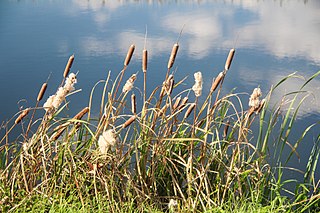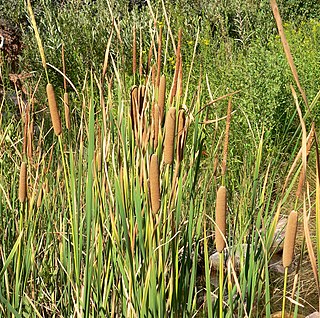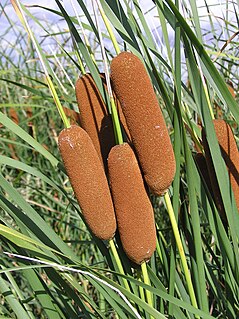
Typha is a genus of about 30 species of monocotyledonous flowering plants in the family Typhaceae. These plants have a variety of common names, in British English as bulrush or reedmace, in American English as reed, cattail, or punks, in Australia as cumbungi or bulrush, in Canada as bulrush or cattail, and in New Zealand as raupo. Other taxa of plants may be known as bulrush, including some sedges in Scirpus and related genera.

A zafu or putuan is a round cushion. Although also a utilitarian accessory, it is best known for its use in zazen Zen meditation.

A reedbed or reed bed is a natural habitat found in floodplains, waterlogged depressions and estuaries. Reedbeds are part of a succession from young reeds colonising open water or wet ground through a gradation of increasingly dry ground. As reedbeds age, they build up a considerable litter layer that eventually rises above the water level and that ultimately provides opportunities in the form of new areas for larger terrestrial plants such as shrubs and trees to colonise.

Typha latifolia is a perennial herbaceous plant in the genus Typha. It is found as a native plant species in North and South America, Eurasia, and Africa.

Typha angustifolia L. is a perennial herbaceous plant of genus Typha. This cattail is an "obligate wetland" species that is commonly found in the northern hemisphere in brackish locations.

Bolboschoenus fluviatilis, the river bulrush, is a species of flowering plant in the sedge family, Cyperaceae. Its range includes Australia, New Zealand, New Caledonia, Canada, the United States, and northeastern Mexico. B. fluviatilis and its fruits are important as food sources for waterfowl such as geese, ducks, bitterns, and swans. It also provides cover and nesting sites for these and other species of birds, as well as small mammals. Like other Bolboschoenus species, B. fluviatilis has strong tubers and rhizomes which help to stabilize intertidal habitats by preventing erosion.

Typha domingensis, known commonly as southern cattail or cumbungi, is a perennial herbaceous plant of the genus Typha.
T. orientalis may refer to:

The shy cosmet moth is a moth of the family Cosmopterigidae. It is known from all of Europe, as well as Asia, Australia and New Zealand. It is also present in North America, where it is distributed from Nova Scotia to Virginia, west to Oklahoma and north to Ontario. The habitat consists of fens and marshes.

Typha orientalis, commonly known as bulrush, cumbungi, or raupō, is a perennial herbaceous plant in the genus Typha. It is native to Australia, New Zealand, Malaysia, Indonesia, Japan, Korea, Mongolia, Myanmar, Philippines, China and the Russian Far East.

Bulrush is a vernacular name for several large wetland grass-like plants

Typha laxmannii, common name graceful cattail, is a wetland plant species widespread across Europe and Asia. Typha laxmannii is not as tall as many of the other species in the genus, rarely more than 130 cm high. A noticeable space separates the staminate (male) flowers from the pistillate (female) ones.

Typha capensis is an aquatic plant known from southern and eastern Africa as far north as Uganda. It has also been reported from Brazil.
Typha shuttleworthii is a species of cattail found in southern Europe as well as in Iran and Turkey.
Typha changbaiensis is a plant species native to the Changbai Mountains in the Jilin province of northeastern China. It grows in freshwater marshes.
Typha davidiana is a plant species native to China. It grows in freshwater marshes and on the banks of lakes and streams.
Typha elephantina is a plant species widespread across northern Africa and southern Asia. It is considered native in Algeria, Egypt, Libya, Mauritania, Senegal, Chad, Eritrea, Ethiopia, Turkmenistan, Tajikistan, Uzbekistan, Palestine, Israel, Saudi Arabia, Yemen, Yunnan, Assam, Bangladesh, India, Bhutan, Nepal, Pakistan and Burma. It grows in freshwater marshes and on the banks of lakes and streams.
Typha pallida is a plant species native to Kazakhstan, Tajikistan, Uzbekistan and China. It grows in freshwater marshes and along the banks of streams and lakes. The species is closely related to T. minima.
Typha przewalskii is a plant species native to the Manchuria Region of northeastern China and also to the Primorye region in the Russian Far East. The plant grows in freshwater marshes and along the banks of lakes and streams.
Typha × bavarica is a plant of hybrid origin, endemic to southern Germany. It apparently originated as a cross between the two very widespread species T. angustifolia and T. shuttleworthii.Typha × bavarica grows in freshwater marshes.












